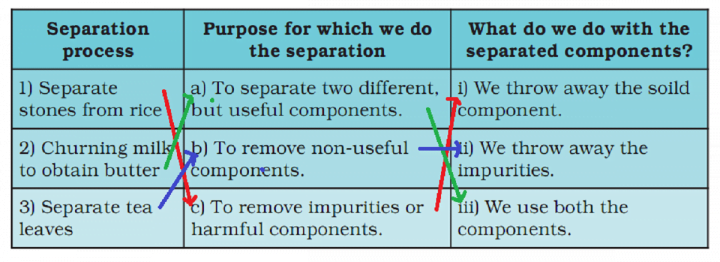Table of Contents
NCERT Class 6 Science Chapter 5 Separation of Substances Activity Solution
Activity 1
Activity 1 asks us to write the purpose of separation of the mixture and how we do it.
Activity 2
Activity 2 asks us to examine a sample of food grain and separate it from impurity.
Answer: Foodgrain contains traces of small stones as an impurity. We do it many by handpicking.
Activity 3
Activity 3 asks us to mix sand with powdered leaves or sawdust and check whether we can separate the components or not.
Answer: Sawdust and sand both are minute particles. We can not separate them as we did in activity 2.
To separate, we need to examine the property of the mixture components. Here sand is heavier while sawdust or leaf powder is light.
In such cases, we use the power of the wind. The wind carries the lighter particle for more distance. So we pour the mixture from a height. Here wind moves the sawdust or leaf powder away from the sand. Such a process where we use the wind to separate mixture is called Winnowing.
Activity 4
Activity 4 asks us to mix finely powdered chalk with wheat flour and check if we can separate them.
Answer:
Finely powdered chalk and wheat flour both are lightweight substances. We cannot separate them as we did earlier by winnowing.
Here we pass the mixture into a sieve. Sieve has very small pores. If one substance is more significant in size, it remains trapped in the sieve, while particles of smaller size pass through the sieve.
In our case, finely powdered chalk will pass through the sieve, but flour will remain in the have only. Thus we can separate the mixture.
Such a case where we use a sieve to separate the mixture, we call the process Sieving.
Activity 5
Activity 5 asks us to separate mud and water from muddy water.
Answer:
Mud after sometime settles to the bottom. We call this process Sedimentation. Here insoluble heavier particles settle at the bottom with time.
Even after sedimentation, we further purify it by Filtration using cloth or filter paper. Cloth further separates the small particles which are present in dirty water. For further purification, we filter paper. Filter paper has very fine pores which we cannot see with eyes. They completely filter the mud from the water.
Activity 6
Activity 6 asks us to mix salt with water and check whether we can separate them into components or not.
Answer:
Salt is completely soluble in water and does not change the colour of the water.
We separate them by heating. On heating water evaporates while salt remains in the beaker.
It will be interesting for you to know that we get salt in our home from the same method. Seawater contains salt. Salt industries get salt by evaporating them and supply our house after further purification. We call this process Evaporation.
Activity 7
Activity 7 asks us to mix salt with sand and check if we can separate them.
Answer: We cannot separate salt and sand by winnowing or sieving as both have similar weight and size. To separate salt from sand, we make use of solubility of the salt in water. Here we add water to the mixture. We remove sand through sedimentation and decantation. Now salt lies in water which we can get through evaporating the solution.
Activity 8
Activity 8 want to know how much quantity of salt we can add to water.
Answer: There is a limit of adding salt to the water. Beyond that, the salt does not dissolve as lies at the bottom.
Fact: We can dissolve 35gm of salt in 100 ml of water. That meant if a spoon is of 5gm size, beyond seven spoons in 100ml water salt will settle at the bottom. Such a solution we call Saturated.
Activity 9
Activity 9 asks us to heat a saturated solution and check if more salt can be dissolved or not.
Answer: Increase in temperature increases the solubility of the substance. So, here we can dissolve more salt.
Activity 10
Activity 10 asks us to prepare two separate saturated solutions, one with salt and other with sugar. It also asks us to compare the result.
Answer: Salt is more soluble in water than sugar. We can dissolve seven spoons of salt each weighing 5gm in 100ml water. While after adding four spoons of sugar that is 20 gm in 100 ml of water.
Related topics
- 4. Sorting Materials into Groups.
- 5. Separation of Substances.
- 6. Changes Around us.
- 7. Getting to Know Plants.
